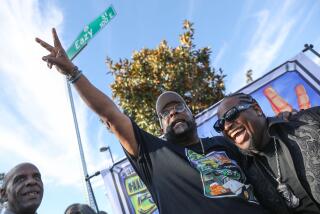Reconsidering a Legend
- Share via
Big Nose Kate’s saloon in Tombstone, Ariz., is the perfect place for a debate about Wyatt Earp. It has a long mahogany bar where perfumed women in low-cut dresses snuggle up to men in greatcoats and slant-heeled cowboy boots, and the piped-in music sounds as if it came straight from “My Darling Clementine,” John Ford’s 1946 movie about the legendary lawman. Faux gunfire sounds in the street outside, where re-enactors brandish hog-leg pistols to entertain the tourists.
Inside, Terry Clanton, a distant cousin of Earp nemesis Ike Clanton, is complaining that history remembers his kin as a moldy scoundrel and coward, but paints a romantic picture of Earp--and a seriously wrongheaded one, in Clanton’s mind--as a white knight, a savior of men, women and the decent way of life.
“People are so into Earp it’s almost at the cult stage,” says Clanton, animated beneath his cowboy hat--which is black, of course. “He’s like Superman or Spider-Man to them, and you can’t talk bad about him. Nobody wants their hero knocked down.”
Earp died in 1929 at age 80 in a bungalow in Los Angeles. He had spent his last few years making friends in Hollywood, and that guaranteed that the first draft of his story, at least, would be told his way. And sure enough, his name and reputation have grown far beyond anything he accomplished in life.
Brad Pitt is in Canada making a movie about Jesse James, and when it comes out James will, no doubt, be the Old West celebrity of the moment. But he won’t last. Wyatt Earp won’t be knocked off the throne built since his death by a steady stream of books, magazine articles, cable TV specials and now a stage play performed by a retired Arizona insurance agent named Wyatt Earp, a great-grandnephew of Earp’s half-brother Newton, who averages one show a week in various venues and has performed in England, Ireland and Hungary.
To this day, Earp groupies leave gifts of poker chips and bullets on his grave at Hills of Eternity Memorial Park in Colma, Calif., and general manager Judy Edmonson says that so many bullets litter the grass that groundskeepers hunt for them before mowing, fearing lawnmowers might set them off. When True West magazine puts Earp on its cover, “sales go up,” says Bob Boze Bell, the magazine’s executive editor. “Earp’s our Michael Jordan.”
Which brings us back to Terry Clanton and his complaints in Big Nose Kate’s. Does Wyatt Earp deserve this exalted status?
Clanton aside, many experts will tell you no, not even close. Neil Carmony, the editor or author of 15 Western history books, notes that scholars have written histories of Arizona territory and find Earp of so little interest that they mention him only in passing. It’s not the scholars, though, that are keeping all the shiny memories alive.
“We’ve romanticized the frontier,” says Carmony. “We like stories of good and evil and we like heroes, but most heroic stories have no foundation in fact. It’s all folklore. I suppose somebody had to bubble to the top of all this interest.”
In recent years, unknown particulars about Earp’s life have come to light, not all of them flattering. This business of digging up tidbits, positive or negative, has a name: Earpiana. And you’d figure that Earpiana would give Clanton and his kind some hope, figuring as they do that the truth will set everyone free.
But after True West in 2003 published stories on evidence that Earp had been a pimp during his early years in Peoria, Bell recalls, his defenders flooded Internet chat rooms with denunciations of the allegations. Don’t ever doubt the passion that Earpiana fans have for Wyatt who, prior to Tombstone, lived a life no more spectacular than did other men of his day.
He was well-built and blond and hailed from Illinois, which he left to make a living hunting buffalo and freighting supplies across dangerous territory in California and Arizona. He also worked as a lawman; his first such job was in Lamar, Mo., in 1870, when he was almost 22.
He later moved to the wild Kansas cow towns of Wichita and Dodge City and earned a reputation as a master intimidator with an uncanny ability to control men. He could walk into a roiling crowd of drunken cowboys, finger the instigator and literally slap him into submission. He sometimes cracked his revolver over the troublemaker’s head, a practice known as “buffaloing.”
Good as he was, other Western lawman did just as much, and for longer periods. Earp spent far more time gambling (in 1911 he was busted at a crooked faro game in L.A., giving police a phony name) than he did cracking skulls. All told, he wore a badge for just a few years.
But Earp’s resume had something that others didn’t: the Oct. 26, 1881, O.K. Corral gunfight, probably the most famous 30 seconds of blood and noise in U.S. history.
The story is well known. Three Earp brothers--Morgan, Wyatt and Virgil, who was the marshal of Tombstone--and their dentist-friend Doc Holliday stood down the cowboy-outlaws of Tombstone, killing three in a face-to-face shootout. The dead included teenager Billy Clanton, Ike’s brother. Unarmed, Ike had scampered away as the gunfight began, forever sealing his reputation, rightly or wrongly, as a coward.
The cowboys, who had been waylaying stagecoaches, rustling and generally wreaking havoc, got revenge two months later by ambushing Virgil, badly wounding him. Shortly thereafter they killed Morgan as he played pool in a Tombstone saloon. One of the bullets slammed into the wall just above Wyatt’s head.
Now comes the O.K. Corral’s third act, unknown to many casual observers.
Earp hunted down and killed at least four members of the cowboy gang, two in brutal fashion. He and his posse found Frank Stilwell, the likely triggerman in Morgan’s murder, at the Tucson train yard and opened up at close range. When the sun rose the next morning, March 21, 1882, passersby discovered Stilwell’s shot-up body lying near the tracks.
Earp found another of the supposed cowboy hit men outside Tombstone and delivered similar justice. The third and fourth killings occurred during an extraordinary shootout, touched off when Earp and his crew rode unwittingly into a cowboy campsite. When the cowboys opened fire, the men with Earp bolted except for Texas Jack Vermillion, who was trapped beneath his wounded horse. Earp stayed put, his shotgun belching smoke against a fusillade from the other side.
Earp’s coat was shredded by bullets. The pommel of his saddle was shot off inches below his face as he clamored to remount his horse, and another bullet slammed into his boot heel. He emerged unscathed, but his chief opponent, Curly Bill Brocius, was dead, nearly cut in half by Earp’s shotgun. Another outlaw died later of his wounds.
Anyone looking to build a Wild West legend can stop right here: Wyatt Earp lived hard by the law until assassins out to murder his brothers and himself forced him to abandon everything he stood for and launch a spectacular killing spree, a vendetta that cleaned out the lawless element.
Historian Bruce Catton first sounded the theme of Wyatt-as-icon in a column published in the Reno Evening Gazette only 15 days after Earp’s death. That legend took off in 1931, when Stuart Lake, a former press secretary to Teddy Roosevelt who had spent time with Earp in L.A., published “Wyatt Earp: Frontier Marshal.” The thrilling, beautifully written tale ignited interest in other writers and movie makers, each building on the one before to create the cardboard figure we have today.
Lake’s genius included using O.K. Corral in his text even though the fight didn’t take place in the corral; it went down in a nearby vacant lot. Paul Andrew Hutton, executive director of the Western History Assn., says Lake knew the exact location but “immediately saw the power of that wonderfully alliterative name” and found it too good to pass up.
It helped that Earp lived to old age. With most of his contemporaries gone by the time he moved to L.A., he became a living relic of the frontier. That status, says Carmony, was built largely on inflated “yarns” Earp spun to Lake. Earp was a U.S. deputy marshal when Stilwell was gunned down in Tucson, but Earp wasn’t in town to conduct official business, only to help his brother Virgil board a train to California. And he had no warrant. “It was personal,” Carmony says. Even at the time of the shootout, “those cowboys were no threat to the people of Tombstone.”
Many don’t know that after the O.K. Corral, Earp and Holliday were jailed, pending an inquiry to determine whether they should be tried for murder. The judge declined. A Pima County grand jury did indict Earp for murder in the Stilwell killing, but he fled the territory and was never extradited.
Still, the Earp-as-knight crowd prevails. In fact, to lure tourists downtown, Tucson has cashed in on the Stilwell killing with a commemorative statue of Earp.
Casey Tefertiller, a former San Francisco sportswriter and author of the highly regarded 1997 book, “Wyatt Earp: The Life Behind the Legend,” advises looking at Earp from the perspective of his times, when lawlessness in Arizona was so prevalent that the Mexican government established military camps to stop cross-border rustling and robbery.
Tefertiller places Earp’s actions in a context greater than simple revenge. He sees him as a just man in an unjust society stepping outside the law in a time of chaos to become the law unto himself.
“I can’t think of anything like it in American history,” Tefertiller says. “It lives on because it’s part of us and relevant today in cities across the country where laws don’t preserve order, and the police can’t protect the citizenry. What’s more important, preserving order or following the law? What’s a just man to do? This is at the heart of the Earp story.”
Tefertiller says people today judge Earp’s actions according to their own values. Those partial to the ACLU tend to think he represents everything wrong with police work; those who favor order and protection say his approach is exactly what’s needed. Either way, Tefertiller says Earp had the courage to act. Modern men often place themselves in the same situation and ask: Would I have the same courage? That also frames the matter in personal terms, ceding to Earp a power other Western figures don’t command.
“He wasn’t what we’d call a good man like Billy Graham, but he had so much courage, and we don’t often see that,” Tefertiller says. “He stood up when he had to.”
True West’s Bell, who says there’s nothing in Old West history to match Earp mania, finds the hero worship fascinating. He describes Earp as a jerk. “But he was a brave jerk,” says Bell. “As someone once said about Wyatt, all the bullet holes were in the front. I’ll give him that much.”
Back in Tombstone, Terry Clanton, who visits every year for the annual Clanton Days Rendezvous, a reunion and opportunity to remake Ike’s reputation, can’t escape the Earp whirlwind. With the bat-wing doors of Big Nose Kate’s thumping intermittently, he describes the page of his website where visitors can write tributes to Ike Clanton.
Here’s a sample: “Ike, you SOB. You have ended up being remembered by history as the spineless rat you were known as during your lifetime.” Many others express similar contempt. Clanton, who goes by Ike, is thinking of compiling the eulogies into a book: “Everybody Hates Me,” by Ike Clanton.
More to Read
The biggest entertainment stories
Get our big stories about Hollywood, film, television, music, arts, culture and more right in your inbox as soon as they publish.
You may occasionally receive promotional content from the Los Angeles Times.










